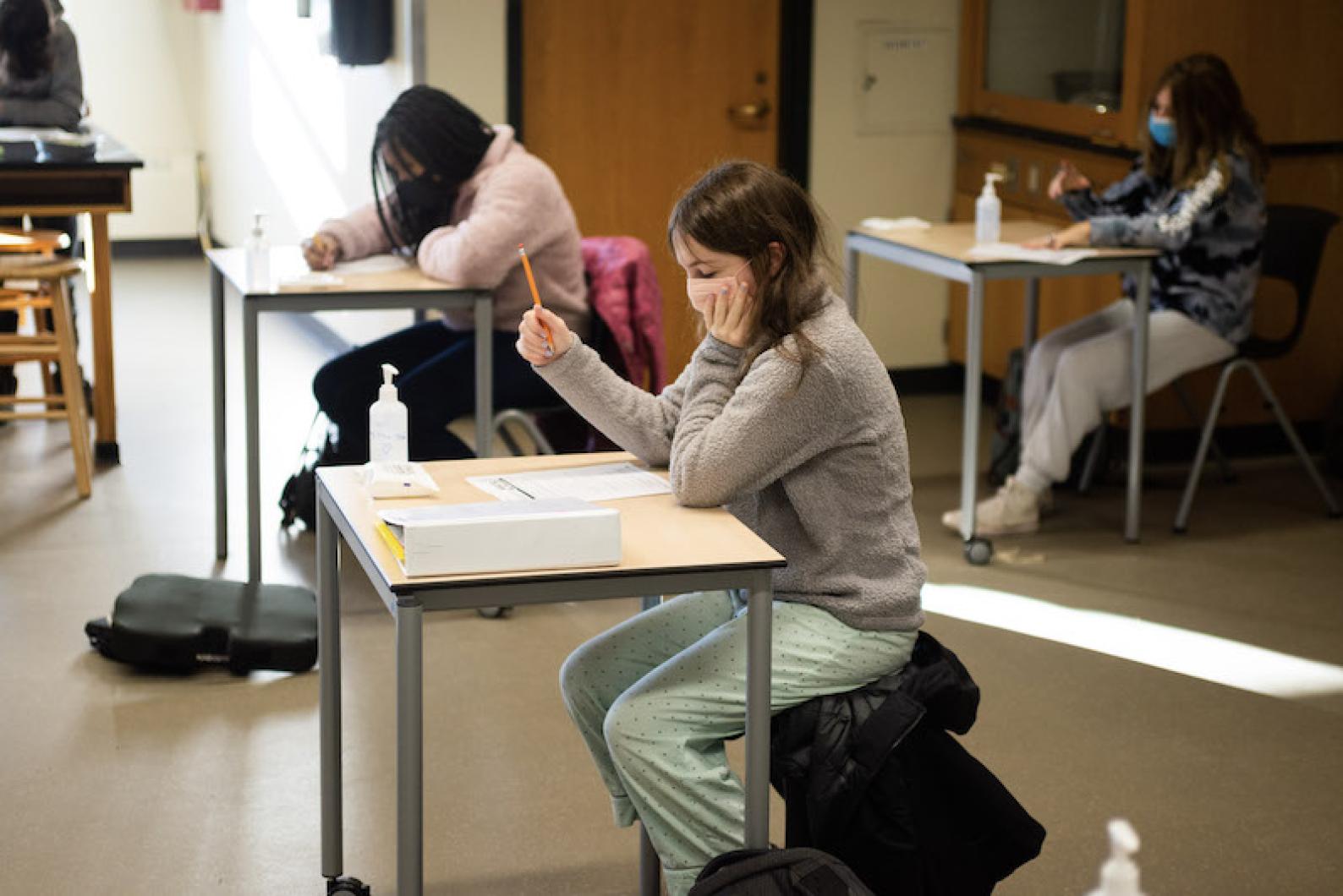Gov. Charlie Baker announced a plan this week to bring elementary and middle school students across the commonwealth back to the classroom full time this spring, pushing Island school officials to finalize reopening plans and bring a complex, year-long school re-entry process to a conclusion.
The state plan, proposed by education commissioner Jeffrey Riley and Governor Baker Tuesday, aims to require all districts in the state to offer in-person instruction for elementary and middle schoolers five days a week beginning in April, by slowly phasing out remote learning options. The plan does not include a clear directive for high schoolers, who pose greater community exposure risks.
“Our administration has been clear for months that the best place for kids is in the classroom,” Governor Baker said Tuesday.
The plan is under review by the Massachusetts Board of Education.
It comes amid a monthlong decline in Covid-19 cases in the commonwealth, with state education experts continuing to report low incidences of in-school transmission almost a year after the pandemic forced teachers and administrators to move classes online.
On the Island, where case counts have been similarly dropping, the announcement represents a hastening — not a shift — in the plan to return to in-person learning.
Vineyard schools superintendent Matthew D’Andrea praised the state move.
“The plan has always been to keep working toward getting students in full days, five days a week,” said Mr. D’Andrea, who attended a meeting with Commissioner Riley and commonwealth superintendents about the proposal Wednesday. “Certainly, guidance that the state provides absolutely is helpful . . . but we are going in that direction anyway,” he said.
Re-entry at the five Island elementary schools has been incremental, bolstered by a school-wide testing program and numerous safety regulations. The process paused briefly in November, when case counts peaked, but has since resumed. As of this month, the Chilmark and West Tisbury schools are operating in person five days a week, while the Oak Bluffs and Edgartown schools have adopted a staggered four-day week schedule. At the Tisbury School, K-4 are in-person five days a week and middle schoolers alternate between remote and in-person weeks. The regional high school is using a hybrid model.
The Vineyard’s system is 80 per cent in-person — advanced compared to other commonwealth districts, 20 per cent of which are still entirely remote, officials said.
Mr. D’Andrea said he aims to have young students back in classrooms full-time, Islandwide by April 1. All-remote learning will remain available through the end of the school year, he said.
“My goal is certainly as soon as possible, but I do recognize there’s work to be done,” said Mr. D’Andrea. “This is not just my decision.”
But numerous challenges mark the course ahead.
At the Tisbury School, principal John Custer said an aging building has posed myriad spacing impediments, complicating moves to bring large numbers of students back sooner.
“The big sort of disclaimer, which has been true throughout the year is if the conditions support it,” Mr. Custer said. “In general we want to make sure that there are healthy and safe conditions . . . [and] we have to make sure that the classrooms can accommodate the kids.”
Mr. Custer said based on current in-person enrollment numbers, he expects to be able to accommodate all students this spring, but he said room assignments will likely have to be shifted and alternate spaces, like the gym, might come into play.
Mr. D’Andrea said with all elementary and middle schoolers returning to the school system, the district’s policy for six-foot distancing will likely need to be reduced to match the state’s less stringent guidelines.
“It really comes down to the distancing requirement and the conversations around comfort with reducing the six feet to three. That’s going to be a challenge,” he said.
Teachers’ comfort levels with in-person instruction could also play a role, particularly as the state continues to delay vaccinations for educators and essential workers in phase two.
“If we can get our staff vaccinated sooner rather than later that will be helpful,” Mr. D’Andrea said. “We have a lot of safety measures — the masking, the distancing, the hand-washing, the testing, which is tremendously helpful. Another safety measure, like having people vaccinated will be even more helpful.”
Union representatives from the Martha’s Vineyard Educators Association could not immediately be reached for comment Wednesday.
But Mr. D’Andrea said he anticipates most teachers will be in favor of the shift, with no plans to reopen the union’s memorandum of understanding with school administrators.
“The teachers have been great,” Mr. D’Andrea said. “They recognize that it’s best to have kids in school, they recognize that in-person instruction is best and they want to be teaching our kids in person.”
He said he expects parents will also support the plan.
“I think [families] want their kids back in school, they recognize the importance of it,” said Mr. D’Andrea. “I think going back as close to being fully in-person as possible will be welcomed.”
Plans for re-entry are set to take shape in March with the help of Island school committees and health and safety subcommittee, Mr. D’Andrea said.
As the prospect of once again filling hallways and cafeterias with Island students inches toward reality, school officials reflected on the long road back to the classroom this year.
“The biggest challenge is that we’ve oftentimes, in making plans, had to weigh what we know is best educationally against what is responsible for public health and safety. And sometimes, those things compete with one another,” said Mr. Custer. “Hindsight is 2020 . . . [but] I think in general our approach has been cautious and I think for the most part that’s been that’s been prudent.”
Mr. D’Andrea echoed the sentiment.
“I think it’s the right move for our district . . . and I think it’s the right move for schools across the country,” he said.







Comments (1)
Comments
Comment policy »